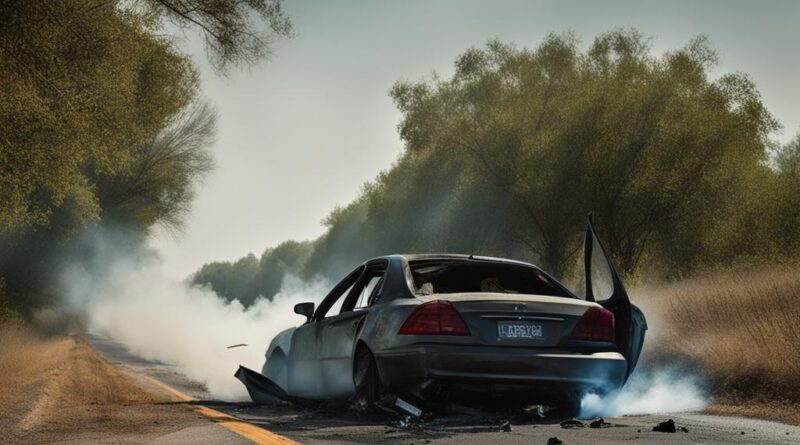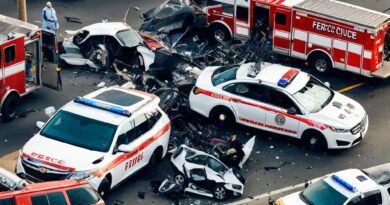Single Car Accident: Dangers of Leaving the Scene
Leaving the scene of a single-car accident can have serious legal consequences. It is important to understand the risks involved and the potential penalties for leaving the scene.
Key Takeaways:
- Leaving the scene of a single-car accident is considered a hit and run, and can result in legal consequences.
- Penalties for leaving the scene of an accident can include fines, license suspension, and even jail time.
- Reporting the accident and ensuring the safety of all involved parties is crucial.
- Properly documenting the accident is important for insurance claims and potential legal cases against third parties.
- Contacting an attorney can provide guidance and representation for pursuing legal action or seeking compensation.
Types of Single-Vehicle Accidents
Single-vehicle accidents can happen in various ways, presenting different scenarios that drivers may encounter. Understanding these types of accidents can help increase awareness and promote safer driving practices.
Driving off the Road
One common type of single-car accident is driving off the road. This occurs when a vehicle veers from its designated lane and ends up on the roadside, a ditch, or even in a nearby field. It can happen due to distracted driving, fatigue, poor road conditions, or a sudden maneuver to avoid an obstacle.
Hitting Objects on the Road
Another type of single-vehicle accident involves hitting objects or debris on the road. This can include colliding with stationary objects like poles, signposts, or parked vehicles. It can also involve hitting debris that has fallen onto the road, such as rocks, branches, or even fallen cargo from other vehicles.
“It is important for drivers to remain focused and attentive, scanning the road ahead to anticipate any potential obstacles or hazards.”
Colliding with Animals, Rocks, or Trees
Single-car accidents can also occur when a vehicle collides with animals, rocks, or trees. This can happen in rural areas where wildlife may cross the road unexpectedly or in mountainous regions with winding roads and limited visibility. Collisions with large rocks or trees can cause significant damage to the vehicle and pose a risk to the occupants.
Leaving the Scene: Legal Consequences
Leaving the scene of a single-car accident can have severe legal ramifications. Even if there are no injuries or property damage, this act is considered a misdemeanor. However, if the accident results in damage or injury, it becomes a hit and run felony charge, leading to more severe penalties, including potential jail time.
Leaving the scene of an accident is a serious offense that undermines the safety and well-being of others on the road. It is essential to understand the gravity of the situation and the potential consequences that may follow.
Hit and Run Penalties
The penalties for a hit and run felony charge can vary depending on the jurisdiction and the specific circumstances of the incident. These penalties typically include:
- License suspension or revocation
- Fines ranging from hundreds to thousands of dollars
- Probation
- Mandatory community service
- Restitution to the victims
- Potential jail time, which can range from several months to several years
It is important to note that hit and run penalties can significantly impact an individual’s driving record and may result in higher insurance premiums or difficulty obtaining coverage in the future.
Comparing Hit and Run Penalties
| State | Felony Charge Penalties |
|---|---|
| California |
|
| Texas |
|
| Florida |
|
These penalties serve as a deterrent and emphasize the importance of taking responsibility for one’s actions and addressing the consequences of a single-car accident.

Importance of Reporting the Accident
When involved in a single-car accident, it is crucial to gather and document all the necessary information. This documentation serves several purposes and can greatly impact the outcome of the situation.
Firstly, documenting the accident is vital for filing an insurance claim. Insurance companies typically require detailed information, such as the date, time, and location of the incident, as well as any relevant photos or videos. This documentation strengthens your case and increases the likelihood of receiving compensation for damage to your vehicle or any injuries sustained.
Furthermore, documenting the accident is essential if you intend to make a case against any third parties involved. In some single-car accidents, external factors may have played a role, such as poor road conditions or defective car parts. By collecting evidence and thoroughly documenting the incident, you can potentially establish liability on the part of these third parties and seek appropriate compensation.
While it may seem unnecessary to document an accident with no injuries or apparent property damage, bear in mind that some injuries or vehicle damage may not be immediately evident. It is always better to err on the side of caution and preserve the necessary evidence.
The Importance of Photos and Descriptions
One of the most valuable forms of documentation is photographs. Take pictures of the accident scene from multiple angles, capturing any visible damage to your vehicle, nearby objects, and road conditions. These photos can provide critical evidence for your insurance claim or potential legal action.
In addition to photos, provide detailed descriptions of the accident. Include factors such as weather conditions, road signage, and any other relevant information that could support your case. The more comprehensive your documentation, the stronger your position when making a claim or presenting evidence to a third party.
Documenting the accident is not only essential for your immediate needs but can also have long-term benefits. By diligently preserving the necessary information, you can protect your rights, ensure fair compensation, and hold third parties accountable for their involvement in the incident.
Insurance Coverage for Single-Vehicle Accidents
When it comes to single-vehicle accidents, having the right insurance coverage is crucial. Depending on your policy, these accidents may be covered under collision insurance or comprehensive insurance. Understanding the extent of coverage and the documentation required can help you file a successful claim and avoid unnecessary financial burdens.
Collision Insurance
Collision insurance provides coverage for damage to your vehicle resulting from a collision with another vehicle or object, regardless of fault. This type of coverage is particularly useful in single-car accidents, as it protects you financially in case you collide with a stationary object, such as a tree or utility pole.
Comprehensive Insurance
Comprehensive insurance, also known as “other-than-collision” coverage, protects against damage caused by events other than a collision. These events may include theft, natural disasters, falling objects, vandalism, or animal collisions. It is important to check your policy to see if single-vehicle accidents are covered under comprehensive insurance.
Here is a comparison of collision insurance and comprehensive insurance coverage for single-car accidents:
| Details | Collision Insurance | Comprehensive Insurance |
|---|---|---|
| Coverage | Damage from collisions with other vehicles or objects. | Damage from non-collision incidents like theft, vandalism, or natural disasters. |
| Financial Protection | Provides coverage for repair or replacement costs of your vehicle. | Covers repair or replacement costs for non-collision-related damages. |
| Documentation | Generally requires a police report to file a claim. | May require additional documentation depending on the nature of the incident. |
| Premium Cost | Costs can vary based on factors such as your driving history and vehicle make/model. | Rates may be influenced by your geographic location and the likelihood of certain incidents. |
When involved in a single-vehicle accident, it is important to consult your insurance provider to understand the specifics of your coverage and the documentation required to file a claim. Promptly reporting the accident and providing accurate information can help expedite the claims process and ensure you receive the appropriate reimbursement.
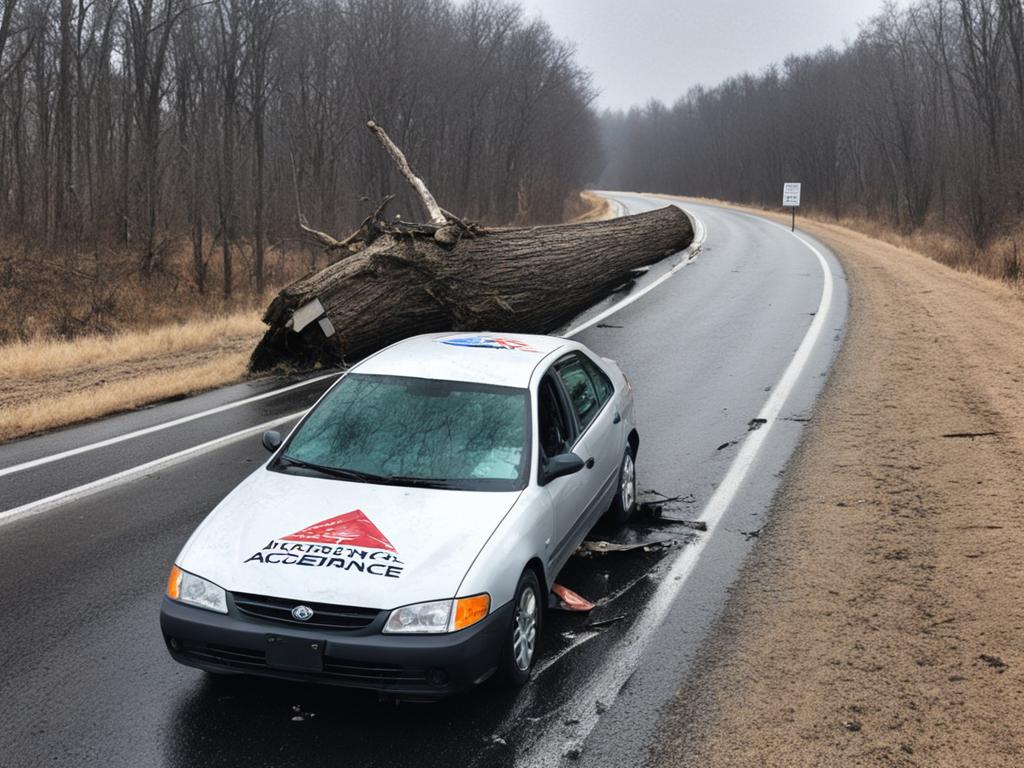
Remember, being prepared with the right insurance coverage can offer peace of mind and financial protection in the event of a single-car accident.
Liability in Single-Vehicle Accidents
In most single-vehicle accidents, the driver of the primary vehicle is held liable for the incident. This means that the driver is legally responsible for any damages or injuries that result from the accident. However, there are certain factors that can influence liability in these types of accidents.
One important factor is negligence. If the driver’s actions or lack of actions directly contribute to the accident, they may be considered negligent. Negligence can include various behaviors such as speeding, distracted driving, or driving under the influence.
Additionally, there are other factors that can influence liability in a single-vehicle accident. Environmental factors, such as inclement weather conditions or poor visibility, can contribute to the accident and shift some of the liability away from the driver.
The condition of the road also plays a role in influencing liability. If the road is poorly maintained, has hazardous conditions, or lacks proper signage, it may be argued that the road itself contributed to the accident.
Defective car parts or mechanical failure can also be a factor in determining liability. If a car part malfunctioned and directly caused the accident, the liability may shift to the manufacturer or the party responsible for maintaining the vehicle.
It is important to note that every single-vehicle accident is unique, and liability can be influenced by multiple factors. Determining liability requires a thorough investigation and analysis of the circumstances surrounding the accident.
Here is a table summarizing the factors influencing liability in single-vehicle accidents:
| Factors Influencing Liability |
|---|
| Negligence of the driver |
| Environmental factors |
| Road conditions |
| Defective car parts or mechanical failure |
Note: The liability in single-vehicle accidents can vary depending on the specific circumstances of each case. It is recommended to consult with a legal professional for accurate advice.
Case Study: Road Conditions Impacting Liability
“I was driving on a rural road during heavy rain when my car hydroplaned and crashed into a tree. The road didn’t have proper drainage, causing large pools of water. I believe the poor road conditions contributed to the accident and that the liability shouldn’t solely fall on me.” – John, a driver involved in a single-vehicle accident.
In this case study, John argues that the road conditions played a significant role in the accident. By demonstrating the lack of proper drainage and the presence of large pools of water, John aims to shift some of the liability away from himself and onto the entity responsible for maintaining the road.
It is essential to gather evidence, such as photographs or witness testimonies, to support any claims related to factors influencing liability in single-vehicle accidents.
Immediate Actions After a Single-Vehicle Accident
Being involved in a single-vehicle accident can be a stressful and overwhelming experience. However, it is important to stay calm and take immediate actions to ensure your safety and gather crucial information. Here are the essential steps to follow:
- Stay Calm: Take a deep breath and try to remain calm. Panicking can impair your ability to make clear decisions and handle the situation effectively.
- Gather Information: Collect as much information as possible about the accident. This includes details about the location, time, and date, as well as any observations about road conditions or other factors that may have contributed to the incident.
- Notify the Police: Immediately contact the local police department and inform them about the single-vehicle accident. This step is important as it allows the police to prepare an official report, which can be useful for insurance purposes and potential legal actions.
- Ensure Safety: Prioritize the safety of yourself and others involved in the accident. If possible, move your vehicle to a secure location away from traffic to prevent further collisions or injuries.
- Assess Injuries: Check yourself and passengers for any injuries. If anyone requires medical attention, call for an ambulance or seek help from nearby witnesses.
Staying calm and taking immediate actions after a single-vehicle accident can greatly contribute to a better outcome. By gathering information and notifying the police, you are ensuring that the necessary steps are taken to address the situation properly. Remember, safety should always be your top priority.
By following these steps, you can lay the foundation for a well-documented incident, which will be beneficial when filing an insurance claim, seeking compensation, or disputing fault. Remember to gather relevant evidence and consult with legal professionals if necessary.

| Action | Importance |
|---|---|
| Stay Calm | To make clear decisions |
| Gather Information | Document the accident details |
| Notify the Police | To prepare an official report |
| Ensure Safety | Prevent further harm |
| Assess Injuries | Determine the need for medical assistance |
Filing an Insurance Claim
After a single-car accident, it is crucial to file an insurance claim to seek compensation for damages and any potential injuries. To increase the chances of a successful claim, there are several important steps that need to be followed:
1. Proper Documentation
Properly documenting the accident is vital when filing an insurance claim. This includes gathering evidence such as:
- Photos of the accident scene
- Damage to the vehicle
- Any injuries sustained
- A detailed account of what happened
Having detailed and accurate documentation strengthens your case and provides evidence of the incident.
2. Vehicle Inspection
Getting your vehicle inspected by a qualified mechanic is important to assess the extent of damage caused by the accident. This inspection report will serve as additional evidence when filing the insurance claim.
3. Reporting to Authorities
Reporting the incident to the appropriate authorities is necessary for both legal purposes and insurance claims. This involves contacting the local police department and providing them with accurate information about the accident.
4. Contacting Your Insurance Provider
Once you have gathered all the necessary documentation, it’s time to contact your insurance provider. Inform them about the accident, provide them with all the relevant details, and submit your claim.
Remember to be honest and transparent with your insurance provider to ensure a smooth and efficient claims process.

By following these steps and providing proper documentation, you can maximize your chances of a successful insurance claim after a single-car accident.
Pursuing a Lawsuit
If the insurance company denies the claim or offers an inadequate settlement, the driver may consider filing a lawsuit to seek legal representation and pursue a fair resolution. Engaging in settlement negotiations or even going to trial can be part of this process.
If you find yourself in this situation, it is advisable to hire a skilled lawyer with experience in personal injury cases and car accidents. The attorney will guide you through the legal process, assess the strength of your case, and provide the necessary legal representation.
To build a strong case, your attorney will gather evidence, such as accident reports, witness statements, and any relevant medical records. They will assess liability and work to prove negligence or misconduct on the part of the other party involved, if applicable.
Settlement negotiations are often the first step in pursuing a lawsuit. Your attorney will skillfully negotiate with the insurance company or the opposing party’s legal representation to reach a fair settlement agreement. These negotiations aim to secure the compensation you deserve for medical expenses, property damage, lost wages, pain and suffering, and other damages resulting from the single-car accident.
If a fair settlement cannot be reached through negotiations, your attorney may advise moving forward with a lawsuit. This involves filing the necessary legal documents, presenting your case in court, and potentially going to trial. During the trial, the evidence and arguments presented by both parties will be evaluated by a judge and/or jury to determine fault and the extent of damages.

Key Takeaways:
- If the insurance company denies your claim or offers an inadequate settlement, you may consider pursuing a lawsuit.
- Hiring an experienced attorney specializing in car accidents and personal injury cases is crucial for legal representation and building a strong case.
- Settlement negotiations are often the first step, aiming to reach a fair agreement without going to trial.
- If a settlement cannot be reached, filing a lawsuit may be necessary, leading to potential trial proceedings.
Defending Against Fault Findings
If you find yourself disputing fault in a single-car accident, it is crucial to gather evidence and present a strong defense to avoid liability. By collecting the right evidence and addressing key factors, you can challenge fault findings and protect yourself from the potential legal and financial consequences.
Gathering Evidence
Building a robust defense starts with collecting compelling evidence to support your case. Here are a few essential pieces of evidence that can help you dispute fault:
- Witness testimonies: Seek out individuals who witnessed the accident and obtain their statements. Their unbiased accounts can provide valuable insights into the events leading up to the accident.
- Photographic documentation: Take photographs of the accident scene, emphasizing any poor road conditions or hazardous obstacles that may have contributed to the incident.
- Vehicle inspection: Have your vehicle thoroughly inspected by a trusted mechanic to identify any defects or mechanical issues that could have played a role in the accident.
Addressing Key Factors
When disputing fault, it’s crucial to address key factors that could influence liability. Consider the following:
Environmental factors: If weather conditions, such as heavy rain or ice, significantly impacted the road conditions, it can be argued that these factors contributed to the accident. Document any weather-related evidence to strengthen your case.
Road conditions: If there were potholes, poorly maintained roads, or inadequate signage, these factors may have played a role in the accident. Document any evidence of road defects to support your defense.
Vehicle defects: If a mechanical failure or defect contributed to the accident, it is essential to gather evidence, such as maintenance records or expert opinions, to establish this as a potential cause of the incident.
By thoroughly collecting evidence and addressing key factors, you can effectively dispute fault findings and increase the chances of avoiding liability in a single-car accident.

Collecting Evidence for Defense
When disputing fault findings in a single-car accident, gathering strong evidence is essential. This evidence can help support your defense and potentially prove that external factors, such as poor road conditions or vehicle defects, contributed to the accident. Here are some crucial steps to follow when collecting evidence:
Gather eyewitness testimonials:
If there were any witnesses present at the scene of the accident, make sure to gather their contact information and ask for their account of what they saw. Eyewitness testimonials can provide valuable insight into the circumstances surrounding the accident and help support your case.
Take photos of road conditions:
Document the state of the road where the accident occurred by taking clear and detailed photographs. Focus on areas that may have contributed to the accident, such as potholes, construction zones, or insufficient signage. These photos can serve as concrete evidence of the road conditions at the time of the accident.
Report road problems:
If you encountered any hazardous road conditions that you believe contributed to the accident, report them to the appropriate authorities. This includes notifying the local transportation department, highway patrol, or municipality responsible for road maintenance. Reporting these issues can help establish a pattern of negligence or lack of maintenance.
Have your vehicle inspected:
Arrange for a thorough inspection of your vehicle by a qualified mechanic or technician. They can identify any existing defects or mechanical issues that may have played a role in the accident. The inspection report can serve as evidence of potential vehicle-related factors contributing to the incident.
By collecting credible evidence such as eyewitness testimonials, photos of road conditions, and vehicle inspection reports, you can strengthen your defense and increase your chances of disputing fault findings in a single-car accident. Remember to consult with your attorney to ensure you gather the necessary evidence and present your case effectively.
Contacting an Attorney
If you have been involved in a single-vehicle accident and are considering pursuing a legal case or seeking compensation, it is crucial to reach out to a skilled single-vehicle accident attorney for guidance and representation. Navigating the complexities of the legal system on your own can be overwhelming, but with the right legal representation, you can increase your chances of a favorable outcome.
An experienced attorney specializing in single-vehicle accidents will have the knowledge and expertise to assess your case, gather evidence, and build a strong argument in your favor. They will guide you through the entire legal process, explaining your rights and options at every step.
When you contact an attorney, they will typically begin by conducting an initial consultation to discuss the details of your accident and evaluate the viability of your case. During this consultation, you will have the opportunity to ask questions, address any concerns, and get a clear understanding of what to expect moving forward.
By working with a single-vehicle accident attorney, you can have peace of mind knowing that your legal representation is dedicated to protecting your rights and fighting for the compensation you deserve. They will handle negotiations with insurance companies, advocate on your behalf, and strive to secure the best possible outcome for your case.
Remember, time is of the essence when it comes to seeking legal representation after a single-vehicle accident. It is important to reach out to an attorney as soon as possible to ensure that crucial evidence is preserved, witnesses are interviewed, and all necessary documentation is collected.
Don’t hesitate to contact a reputable single-vehicle accident attorney today to discuss your case and explore your legal options. They can provide the expert guidance and support you need to navigate the legal process and seek the compensation you deserve.

Why You Need a Single-Vehicle Accident Attorney
- An attorney specializing in single-vehicle accidents understands the intricacies of these cases and can provide valuable insights and legal strategies.
- They have experience dealing with insurance companies and can negotiate on your behalf to ensure you receive fair compensation.
- Legal representation can help strengthen your case by gathering evidence, interviewing witnesses, and building a strong argument in your favor.
- An attorney can guide you through the legal process, ensuring you meet all deadlines, file necessary paperwork, and comply with legal requirements.
- If your case goes to court, an attorney can provide skilled representation, presenting your case to a judge and advocating for your rights.
“Contacting a single-vehicle accident attorney is a crucial step in protecting your rights and seeking the compensation you deserve. Don’t navigate the legal process alone – let an experienced attorney guide you through every step of the way.”
– [Attorney’s Name], Single-Vehicle Accident Attorney
Legal Consequences of Leaving the Scene
Leaving the scene of a single-car accident can have serious legal consequences, including fines, license suspension, and even jail time. It is crucial to understand the potential penalties and the impact they can have on one’s driving record.
When a driver flees the scene of an accident, it is considered a hit and run offense. The penalties for these offenses vary depending on the severity of the accident and the state in which it occurred. Here are some of the common penalties that individuals may face:
- Fines: The hit and run penalties typically include monetary fines, which can range from a few hundred dollars to several thousand dollars.
- License Suspension: In addition to fines, individuals may also face a suspension of their driver’s license. The duration of the suspension varies by state and the circumstances of the offense.
- Jail Time: In more severe cases, hit and run offenses can result in imprisonment. Depending on the state and the seriousness of the accident, individuals may face a range of jail sentences, from a few months to several years.
It is essential to note that hit and run penalties can have long-lasting effects beyond the immediate legal consequences. A suspended driver’s license can impact a person’s ability to commute, affect employment opportunities, and may result in higher insurance premiums in the future.
“Leaving the scene of a single-car accident can lead to serious legal consequences.”
Remember, the responsibility of a driver involved in an accident is not only about their own well-being or their vehicle but also extends to the safety of others on the road. It is crucial to remain at the scene of an accident, report the incident promptly, and cooperate with law enforcement authorities.
Taking the right actions after an accident, such as reporting the incident, can help mitigate the potential consequences. By staying at the scene, providing necessary information to authorities, and cooperating fully with the investigation, individuals demonstrate their commitment to accountability and responsibility.
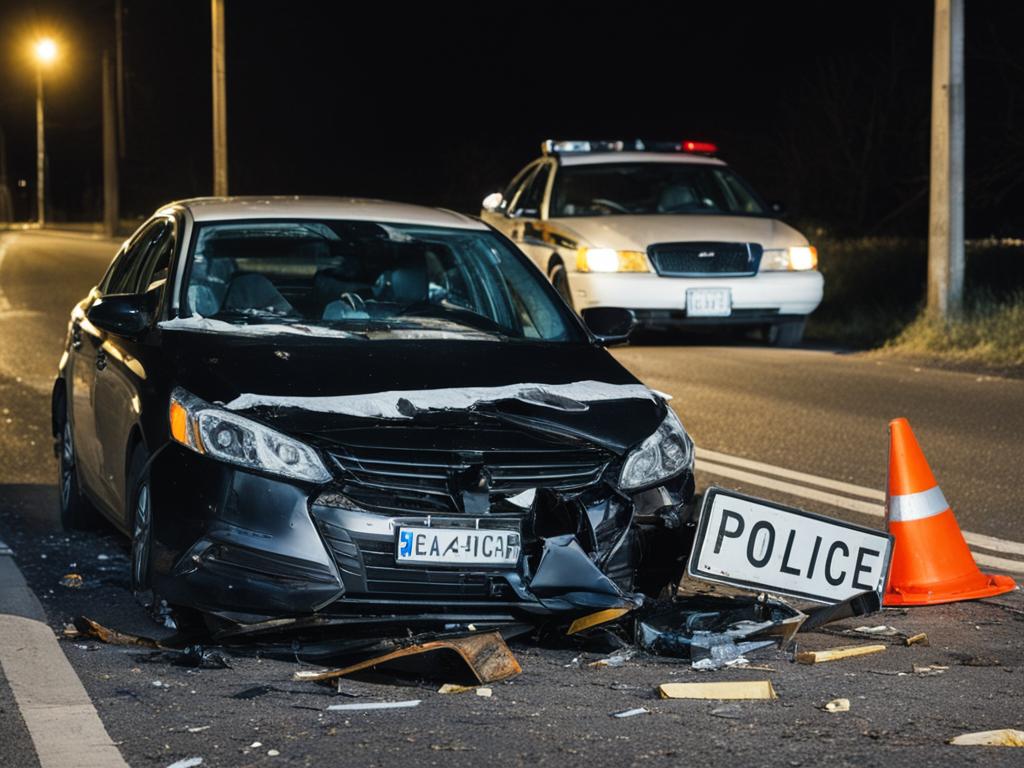
Understanding the legal consequences of leaving the scene of a single-car accident highlights the importance of taking immediate actions, taking responsibility for one’s actions, and complying with all legal obligations. By doing so, individuals can work towards resolving the situation and minimizing the impact on their driving record and overall wellbeing.
Reporting Requirements for Vehicle Collisions
When involved in a vehicle collision that results in property damage only, it may not always be necessary to report the incident to the police. However, it is still important for drivers to exchange information with the other parties involved in the accident. This ensures that all necessary details are documented for insurance purposes, potential legal actions, and to facilitate a smooth resolution.
While reporting to the police may not be required in certain situations, drivers should still consider contacting law enforcement if:
- The collision involves injuries or fatalities.
- The collision involves a government or commercial vehicle.
- The collision is suspected to involve a driver under the influence of drugs or alcohol.
- The driver is uninsured or their insurance information is unverifiable.
In addition to exchanging information and potentially reporting to the police, drivers may also need to file a Report of Motor Vehicle Accident with the Department of Motor Vehicles (DMV) within a specified timeframe, usually within 10 days after the accident. This requirement can vary by state, so it’s important to check the specific regulations in your jurisdiction.
It is crucial to comply with reporting requirements and provide accurate information to the authorities and the DMV. Failure to do so may result in legal consequences and could affect future insurance coverage.
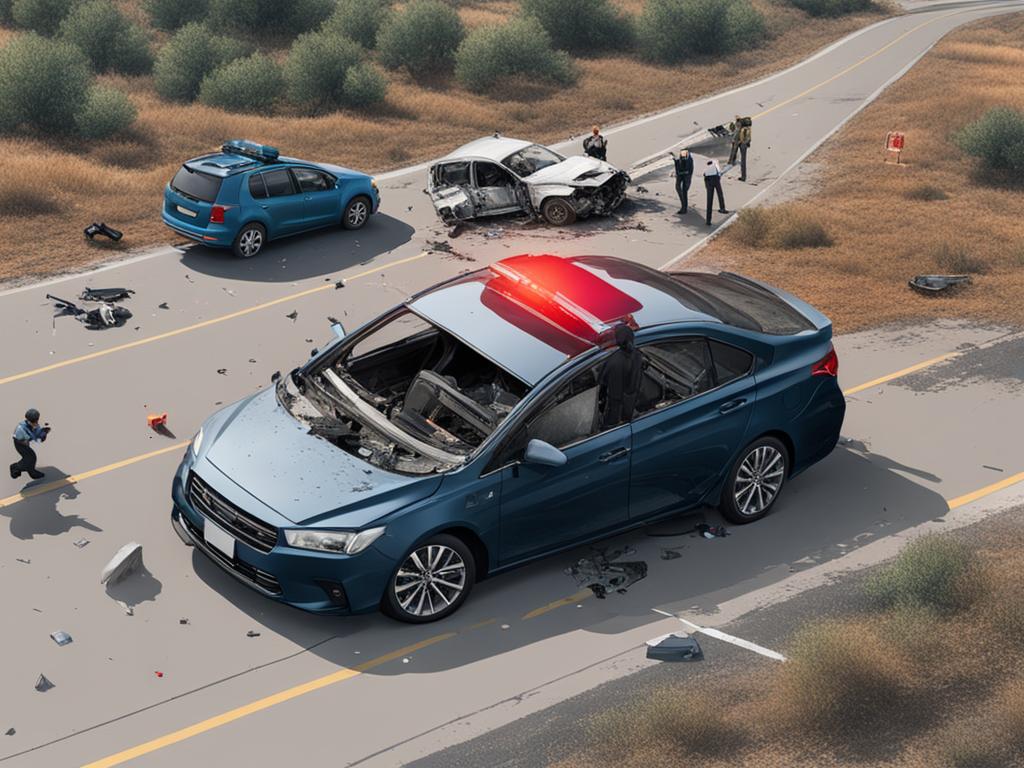
Key Takeaways
- Report property damage-only collisions to the police only if required by law or in certain situations.
- Exchange information with other involved parties, regardless of the need to report to the police.
- Check the reporting requirements of the DMV in your jurisdiction and file a Report of Motor Vehicle Accident if necessary.
Importance of Safety After a Collision
After a collision, the safety of all individuals involved should be the top priority. It is crucial to prioritize safety measures to prevent further harm and ensure prompt assistance. Here are some key steps to take:
- Move to a Secure Location: If possible, move your vehicle to the side of the road or a safe area away from traffic. This helps minimize the risk of additional accidents and allows for a more accurate assessment of the situation.
- Check for Injuries: Immediately assess yourself and others involved in the collision for any injuries. If anyone requires medical attention, contact emergency services right away. Remember, the well-being of individuals should always come first.
- Contact Emergency Services: In situations where there are injuries, significant property damage, or potential hazards, contacting emergency services is essential. Dial the appropriate emergency number in your location to report the collision and request assistance.
Ensuring a Safe and Secure Environment
Creating a safe and secure environment after a collision is crucial to prevent further harm and ensure the well-being of everyone involved. By following these steps, you can mitigate risks and promptly receive the necessary support:
“Safety should be the primary concern after a collision. By moving to a secure location, checking for injuries, and contacting emergency services, you can help minimize risks and ensure timely assistance.”
Conclusion
Leaving the scene of a single-car accident is a serious offense that can result in hit and run traffic violations. Understanding the potential penalties and taking the necessary actions to report the accident and comply with the law is crucial.
Whether there are injuries or property damage involved, it is important to prioritize safety and gather all necessary information about the accident. This documentation will not only help with insurance claims but also potentially make a case against any third parties involved.
When facing a single-car accident, remember the importance of staying at the scene, notifying the authorities, and collecting the proper evidence. By taking these steps, you can minimize the legal consequences and ensure that justice is served.
FAQ
What are the dangers of leaving the scene of a single-car accident?
Leaving the scene of a single-car accident can result in serious legal consequences, including being charged with a hit and run. It is essential to understand the risks involved and the potential penalties for leaving the scene.
What types of single-vehicle accidents can occur?
Single-vehicle accidents can happen in various ways, such as driving off the road, hitting objects or debris on the road, or colliding with animals, rocks, or trees. It is important to be aware of the different scenarios in which single-car accidents can happen.
What are the legal consequences of leaving the scene of an accident?
Leaving the scene of a single-car accident, even without injuries or property damage, is considered a misdemeanor. However, if the accident causes damage or injury, it becomes a hit and run felony charge, which can result in more severe penalties, including jail time.
Why is it important to report a single-car accident?
It is crucial to gather and document all necessary information about the single-car accident, regardless of injuries or property damage. This documentation is essential for filing an insurance claim and potentially making a case against any third parties involved.
What insurance coverage is available for single-vehicle accidents?
Depending on the driver’s insurance coverage, single-car accidents may be covered under collision insurance or comprehensive insurance. It is important to understand the extent of coverage and the documentation required to file a successful claim.
Who is typically held liable in single-vehicle accidents?
In most single-vehicle accidents, the driver of the primary vehicle is held liable. However, there are situations where other factors can influence liability, such as environmental factors, road conditions, or defective car parts.
What immediate actions should be taken after a single-vehicle accident?
After a single-vehicle accident, it is important to stay calm and gather as much information as possible about the accident. This includes notifying the local police department to prepare an official report and ensuring the safety of yourself and others involved.
What steps should I take to file an insurance claim for a single-car accident?
To file a successful insurance claim for a single-car accident, the driver must properly document the accident, get their vehicle inspected, and report the incident to the appropriate authorities. This documentation is crucial for increasing the chances of a successful claim.
What should I do if the insurance company denies my claim?
If the insurance company denies the claim or offers an inadequate settlement, the driver may consider pursuing a lawsuit. This can involve hiring a lawyer, building a case, and potentially going to trial. Settlement negotiations are also a common resolution before trial.
How can I dispute fault findings in a single-car accident?
If the driver believes they are not at fault for the single-car accident, it is important to gather evidence and dispute any fault findings. This can involve collecting witness testimonies, documenting poor road conditions, and addressing vehicle defects.
How can I collect evidence to defend against fault findings?
Collecting evidence for defense is crucial in disputing fault findings in a single-car accident. This can involve taking photos of poor road conditions, reporting road problems, and having the vehicle inspected for any defects.
Should I contact an attorney after a single-vehicle accident?
If the driver has been involved in a single-vehicle accident and wishes to pursue a legal case or seek compensation, it is advisable to contact an experienced attorney. They can provide guidance and representation throughout the process.
What are the legal consequences of leaving the scene of a single-car accident?
Leaving the scene of a single-car accident can lead to serious legal consequences, including fines, license suspension, and even jail time. It is important to understand the potential penalties and the impact they can have on one’s driving record.
Are all vehicle collisions required to be reported to the police?
Vehicle collisions resulting in property damage only may not be required to be reported to the police. However, drivers are still responsible for exchanging information with other motorists and filing a Report of Motor Vehicle Accident with the Department of Motor Vehicles within 10 days if necessary.
What is the importance of safety after a collision?
After a collision, the safety of all individuals involved should be the top priority. This includes moving to a secure location, checking for injuries, and contacting emergency services if necessary. Prioritizing safety can help prevent further harm and ensure prompt assistance.
What are the potential penalties for leaving the scene of an accident?
Leaving the scene of a single-car accident can have serious legal consequences, including hit and run traffic violations. It is important to understand the potential penalties and take the necessary actions to report the accident and comply with the law.

